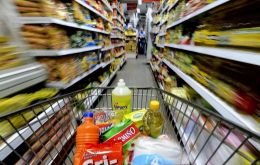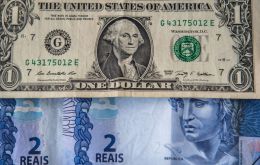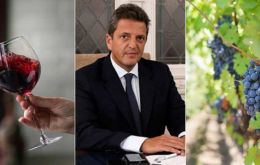MercoPress. South Atlantic News Agency
Tag: US dollar
-
Saturday, December 6th 2025 - 09:36 UTC
Argentina: Dollar keeps falling after new debt plan announcement

Argentina's official exchange rate and key financial dollar segments registered declines on Friday, after Economy Minister Luis 'Toto' Caputo announced plans for a new dollar-denominated bond issuance aimed at refinancing maturities and strengthening foreign currency reserves.'
-
Friday, September 19th 2025 - 10:22 UTC
Dollar soars amid Argentina's political instability

Argentina's Economy Minister Luis Toto Caputo announced on Thursday that the government would sell “every last dollar” to defend the current parity between the Argentine peso and the greenback. He made those remarks following a rise in the official quotation, which pierced the upper limit of its exchange rate band. Caputo insisted this approach fell within the program agreed upon with the International Monetary Fund (IMF).
-
Wednesday, December 4th 2024 - 09:54 UTC
Uruguayans do their shopping in Brazil to capitalize on surging US dollar

Uruguayan retailers in cities bordering Brazil have expressed concern after residents increased their tendency to shop abroad in the face of the recent rise in the US dollar. Meanwhile, duty-free shops are looking for strategies to cushion the drop in sales to the Brazilian public, amid fears of a surge in smuggling.
-
Saturday, November 30th 2024 - 10:25 UTC
Brazil: US dollar pierces R$ 6 barrier

The US dollar closed for the first time above the psychological R$ 6 barrier on another turbulent day in Brazil's markets, Agencia Brasil reported. The local scene continued to reverberate after the spending cut package announced earlier this week by Finance Minister Fernando Haddad, also impacting the stock exchange scene during the day.
-
Thursday, October 31st 2024 - 10:19 UTC
BCP intervention keeps guaraní afloat against US dollar

After an intervention by the Central Bank of Paraguay (BCP) deemed as “timely” in Asunción's financial circles last week, the local currency appreciated against the US dollar and fell further away from the psychological ₲ 8,000 barrier. The BCP pledged to further inject at least US$ 15 million daily into the market, to stabilize the local currency. The dollar went up 9% against the guarani in 2024, largely driven by demand for the dollar in the international market and by local exchange needs.
-
Monday, September 2nd 2024 - 11:38 UTC
Paraguayan businesses concerned as dollar keeps soaring

Given the seemingly unstoppable soar of the US dollar against the local guaraní during a whole week, the Association of Importers and Traders of Paraguay (Asimcopar) said it feared the current trend might hit year-ending sales, which largely feature imported items.
-
Friday, August 16th 2024 - 09:54 UTC
Milei outlines his dollarization plan which will add other currencies

During his appearance at the Expo Real Estate event, Argentine President Javier Milei explained Thursday his currency competition plan and also delved into the matter of closing down the Central Bank, one of his main campaign promises. The head of state also stressed that thanks to the economic adjustment undertaken by his administration a debt rollover for part of 2025 had been guaranteed.
-
Saturday, June 29th 2024 - 09:28 UTC
Brazil: Dollar soars, unemployment falls

The economy in South America's largest country is taking a shaky turn as Friday's figures would indicate. The exchange rate between the local real (R$) and the US dollar (US$) went up 15.15% over the past six months, closing at US$ 1 = R$ 5.58 while the Stock market fell 0.32% for a 1.49% monthly gain. On the brighter side, unemployment in the quarter ending in May stood at 7.1%, according to Brazil's Institute of Geography and Statistics (IBGE), a considerable improvement from February's 7.8% and the yoy 8.3%.
-
Friday, April 21st 2023 - 10:05 UTC
Argentine peso keeps sinking against US dollar

The Argentine peso kept sinking Thursday against the US dollar with the “blue” (a euphemism for “black market”) rate hitting AR$ 440 before closing at AR$ 437/AR$ 432 (buy/sale).
-
Monday, March 6th 2023 - 09:55 UTC
Massa announces “wine dollar” for Argentine producers

The Government of Argentina announced during the weekend the creation of yet another foreign currency exchange rate; one to be applied particularly to wine exports, effective next month.
